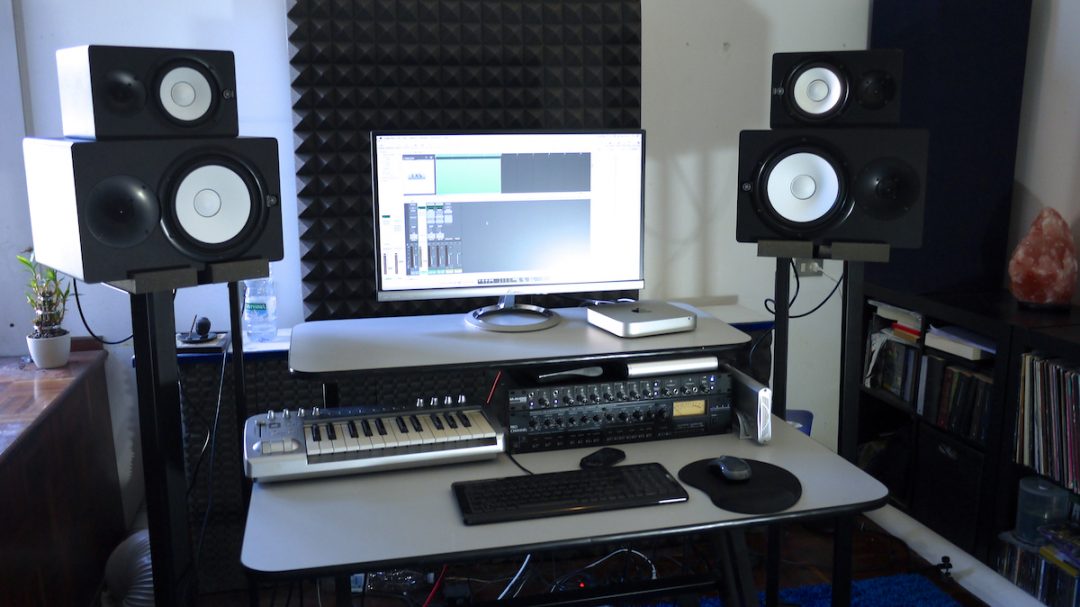It’s 2019: You can make records in your home studio and spend less than $1000 getting set up! Today’s recording tech has given everybody the opportunity to create high-quality music in their bedroom, even with just the bare essentials. We’ll take a look at the top budget DAWs, audio interfaces, studio monitors/headphones, and microphones for home recording on a shoestring.
Inexpensive Home Recording
First and foremost, you’ll need a computer. If you’re reading this, there’s a good chance you already own one, so it won’t be factored into the home studio budget. You’ll just want to be sure it meets the minimum processing requirements of music production. And at this point, Mac vs. PC shouldn’t even be a debate. Most major DAWs run on both.
A fast processor with ample RAM is paramount. While quad-core processors like the Intel i7 can multitask better than dual-cores, a quick dual-core like a 2.9 GHz i5 can handle even very dense projects. Try to run at least 8 GB of RAM to ensure your computer’s viability as a music-making machine.
Your hard drive should be at least 7200 RPM, but SSDs and flash-based storage solutions are increasingly becoming the norm. The faster your computer can think, the smoother your sessions will run.
1. DAW
The digital audio workstation (DAW) is the software you’ll use to record, edit, mix, and master audio, create MIDI arrangements, and perform anything else you can imagine. Everything happens in the DAW, so pick one and learn it well!
The DAW can be totally free. All of the major DAWs, including Pro Tools, Studio One, Cubase, and Ableton offer free downloads. Functionality is limited, but you’ll still be able to record and mix music at a basic level.
If you’re on PC, Cakewalk by BandLab is a complete professional DAW that’s free. Alternatively, Reaper is a very popular option, and a license costs right around $60.
2. Audio Interface
The interface is a hardware component that connects microphones or other instruments to your computer. In the simplest sense, it provides I/O for your studio and sends audio signals to your DAW for recording, commonly via USB.
For many home recording set-ups, two inputs are enough. Now in its 3rd generation, the Focusrite Scarlett 2i2 is an ever-popular option, featuring two preamps and hybrid XLR/TS inputs for microphones or line-level instruments for around $160. There are numerous great, affordable interface options for under $100 as well.
Consider the Behringer UMC22 that can still be had for right around $50!
What you choose is largely dependent on your I/O needs and personal preference.
3. Studio Monitors and Headphones
Studio monitors and headphones are essential. These will probably run up the bulk of the $1000 budget, but will be worth every penny when it comes time to actually make music. I’d recommend splurging just a bit on monitors, as a decent pair will last you much longer than crummy ones. That being said, you can nab a great pair for next to nothing.
PreSonus’s Eris E3.5 are an absolute steal at $99 a pair! The 3.5″ woofer limits low-end reproduction, but there are no doubt quality monitors. If you need a little more beef in the lows, try the 4.5″ version at just $199 a pair.
JBL’s 305p MkII monitors are highly rated as well. At $300 a pair, they’re budget-friendlyish, and you may get more mileage out of them than some of the other inexpensive choices. The 5″ woofer is quite capable, and a standard for nearfields.
Next, you’ll need a pair of headphones for your home studio to monitor while recording. AKG’s K240s have been an industry standard for years and run just $69.
4. Microphones
Beginners should consider investing in one or two “all-around” mics that suit their budget. A large-diaphragm condenser can do just about anything, as can the awesome (and inexpensive!) Shure SM57: a popular workhorse dynamic microphone for $99.
Typically, condensers provide a more articulate frequency response, while dynamic microphones are robust and more tolerant of high-volume sound sources. If you’re a guitarist, you especially can’t go wrong with the aforementioned SM57 on a speaker cabinet. It can also do vocals, drums, and just about anything else. Again, a stereo pair can be had for just $200.
Vocalists or acoustic musicians, on the other hand, may prefer a condenser, like the Røde NT1–an excellent entry-level option at under $300. Røde’s NT1-A is an even more popular budget condenser at just $229. The general consensus is that the NT1-A is brighter or harsher than the NT1–let your own ears be the judge, as both are very affordable.
Consider what you’ll be recording the most and make a decision from there!
5. Accessories
Mic stands and XLR cables will be the most essential accessories for your home studio when you’re starting out. We mentioned the Shure SM57 earlier, which is very commonly bundled with a mic stand and XLR cable. Sweetwater’s is just $129–grab yourself a pair and set your home studio up for success for less than $300.
